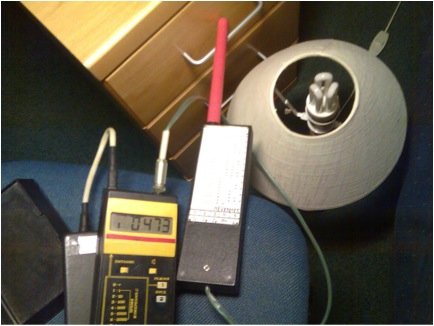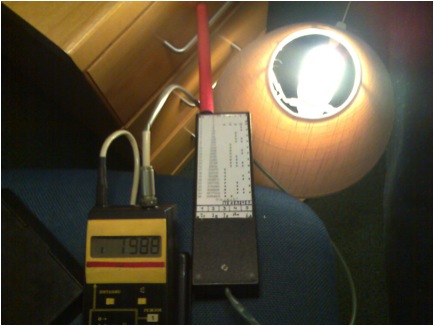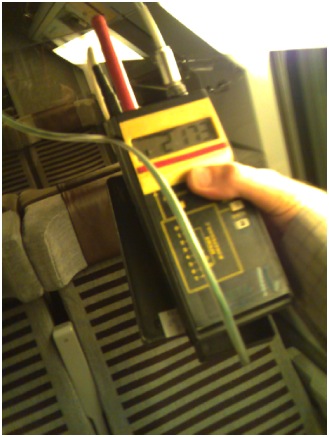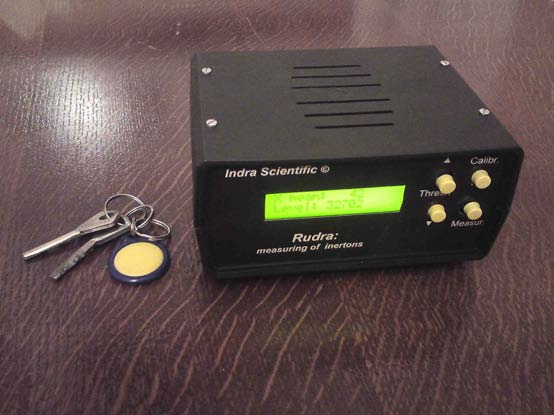
As a physicist whose major interests are found in the areas of
condensed matter physics and fundamental physics,
I would like to inform you about our device that
measures the inerton radiation from different sources,
such as:
1) Galaxies, stars and planets (this allows us to offer
a new branch of
astronomy, namely,
the inerton astronomy);
2) the bowels of the earth and and ruptures of the earth's crust
(the radiation can be measured on building plots,
in residences, etc.);
3) equipments that operate on the basis of electromagnetic power.
An introduction and interpretation of this new physical field,
the inerton field, which is a substructure of the matter waves
of quantum mechanics see in sections
Research Interests
and Recent Events.
In short, the inerton field is a field that emerges at the motion or
vibrations of physical objects, or their parts. Carriers of the field
were called "inertons", as they transfer inert properties of objects,
i.e. they represent carriers of the field of inertia (in one's turn
inertia means a resistance to the motion of an object on the side of
the real physical space).
The physical nature of the inerton field is complete other than that
of the electromagnetic field.
Of course the inerton field influences living organisms.
However, in what way exactly? This probably depends on
the field intensity, a frequency range and doses.
Our recent preliminary research has shown that the frequency range
from Kilo-Hertz to Giga-Hertz very negatively influences the organism.
First of all the field is harmfully affected functional states of
major organs, which is revealed through such symptoms as sick headache,
tired eyes, chronic fatiguability, etc.
As a user of computers, I have tested a number of computers produced by
different companies, among them Samsung, LG Electronics, ViewSonic, IBM, etc.
Together with a colleague Valery Didkovsky who assisted me in the designing
of the device, we measured the inerton radiation from monitors with
the cathode ray tube, processors of office computers and processors
of notebooks, and liquid crystal displays.
What do we measure exactly? A flow of inertons (i.e. quasi-particles, or
excitations of space), which as fundamental as photons. That is, we can
measure the pressure of these particles (a flow of mass that falls on unit of area per unit of time):
the result of measurement is the number of scintillations per n seconds
(where n = 1, 10, 100 seconds).
Thus our device has been designed as a scintillator of
inertons. The reference point was associated with the measurement of
inerton flows in a comparatively pure place situated far-away from
the city, namely, in a field 20 km from the city of Kyiv,
where the device showed 1900 x 1.6 scintillations per
10 seconds (the value 1.6 is the special device factor). In this place
the level of electromagnetic noise was small, about 2 microVolt/meter
(in a frequency range from KHz to GHz). At the same time,
in a city polluted with acoustic and electromagnetic fields,
the background electromagnetic radiation was at
least 103 times more intensive.
In the city of Kyiv, the background inerton radiation has been detected at
the level between 3000 to 4000 scintillations.
It is easy to use the decibel scale (dB):
R = 20 * log ( U / UO )
where U is the value of an inerton signal
measured by the device from the tested source and
UO is the value of the reference signal,
i.e. UO = 1900.
Now about our testing of computers and monitors.
Cathode ray monitors (diagonal = 15") produced in 1998
have showed the inerton radiation at the level of 12 dB
at the distance about 50 cm from the display. Complete flat
cathode ray monitors of modern standards TCO'03 (diagonal = 17") produced
from 2001 to 2005 have shown the inerton radiation in the
value 6 to 21 dB at the level of eyes of a user.
The distribution of inerton field around the
monitor is very chaotic (in particular, the most dangerous
inerton radiation was measured from a display - at the level of eyes -
of ViewSonic company produced in 2004: the device fixed 21 dB).
In addition, the glass of the monitors have shown very strong
gamma-radiation, on average 25 times large in comparison with
the background gamma- and betha- radiation.
Processors have shown the inerton radiation 9 dB
to 14 bB at the distance of 50 cm from the computer's box.
Notebooks have shown radiation 13 dB at the distance
30 cm from the display (IBM ThinkPad, 2000) and about
10 dB (IBM ThinkPad, 2004). Liquid crystal displays show
inerton radiation at the level of 5 to 9 dB.
There was also carried out a preliminary study of the
influence of inerton radiation on the living organism.
Several years ago, in the city of Kharkiv (Ukraine) a few
enterprising architects located several plots with different
levels of geo-pathogenic radiation from the Earth (approximately:
up to 3 dB, up to 5 dB, and up to 7 dB). Mice were celled in
those three zones and their organisms were studied by medical
researchers after three months of living in those cells.
The conclusion regarding the state of health was unpleasant
for the second group of mice and bad for the third group of mice...
We can also use the other scale, namely, the inerton radiation
can be measured in Rudras, i.e. relative values as the ratio
I = U / u [Rudras]
( God Rudra is a personage of the Rigveda; in line with recent deconding
of the Rigveda by Dr. Raja Ram Mohan Roy in his remarkable book Vedic Physics,
this is a handbook about the constitution of the real space, cosmology and
elementary particles; God Rudra was associated by Dr. Roy just with radiation.)
Our team can make a demonstration of the device,
as we understand how it is important to have a complete radiation-free
computers and other electronic technique. We can also propose
a solution of the problem, as we know which parts in computers
should be substituted for 'inerton radiation'-free parts.
We also speak in support of a proposal to carry out independent
medical researches of the influence of inerton radiation on
the human body.
We hope the reader supports our anxiety concerning complete unprotection
of people and the environment from the harmful effects of
inerton radiation.
We will be pleased to collaborate with people interested in the
improvement of the next generation of computers.
Besides, the device is very need to those builders and architecs
who do not wish to offer their customers environmentally vulnerable residences.
The device can also be very successfull at a geological exploration,
because it is capable to indicate oil and gas pools, water pools,
oil-shale deposits, commercial orebodies, etc.
The device can assist archaeologists at their archeological dig, as it
can easy to indicate burial places and recondite entrances, caves, rooms and tunnels;
The device can help researchers of pyramids to determine the intensity of the
the pyramid power.
There is also the hard information that the inerton field is
able to intensify many chemical processes in liquids, up to tens
of thousands times!!
P.S.
In a Ukarinian newspaper ("Molod' Ukrainy", 12-18 January 2006)
journalist Valentina Andriyko published the information about
Russian medical studies of fanatic users of computers who spent all
their time with the computer in 1990s. They have a very serious problems
with teeth and jaw-bones: the necrosis of teeth and jaw-bones.
Teeth become black and both the teeth and the jaw-bones become
to destroy and crumble. A new kind of desease...
( In my opinion, this is the result of nuclear transformations
in bone tissues caused by the inerton radiation )
SUPPLEMENT
In the mid-September 2008 I participated in the conference Physical Interpreation of Relativity Theory, which was held
at the Imperial College London. There I demostrated the device for the measuring of inerton
radiation. I was living in a room at the hotel 'Beit Hall'. Below see the pictures that show how is
dangerous modern energy saver lamps: The first picture shows that the background level of inerton radiation
is 473 pulses per second. The second picture shows that the inerton radiation generated by the energy saver lamp
is 4 times of the background inerton radiation. It is dangerous for the head of a person who is resting in the bed
at which this lamp is set, though the lamp consumes only around 10 Watt of power. A flow of inertons appears due to
very swift processes in such lamps (fast electrons bomard electrodes, i.e. luminophore targets, and these collisions produce
the generation of free inertons). Conversely, a conventional electric light bulb does not generate an inerton flow,
though consumps more energy, because the generation of photons obeys usual electron-phonon processes, i.e.
the phonon system of a metal wire copes with electrons, or in other words, the crystal lattice of
a metal is able to fasten inertons from inerton clouds of rather slow electrons that move in the lattice.


Then I was travelling from London to Brussels by a train. This took 2 hours, some people
including myself wished to try to have a nap, but it was complete impossible:
we all looked very tired and the relaxation did not come to us at all. I decided to measure
the inerton radiation in the coach. The measurement shocked me - see the picture below:
At the place where the head is located the device fixed rather a huge chaotic inerton
flow - over 2000 pulses per second! That was the result of the tiredness of passangers.
Only on the floor in the passage of the coatch
the level of radiation was lowest - about 700 pulses per second.

In 2011 we designed a new version of an inerton measuring device. The device was named
'Rudra' (see the photograph below). The device 'Rudra' is able to measure not only
the intensity of inertons, but also the spectrum of inerton signals in a range
from 1 Hz to 100 kHz. It can be suitable for the study of flow of inertons coming
from both the underground and the sky. The 'Rudra' is very good prototype for the
future tool that will be able to measure inerton signals in a range 1 Hz to 100 MHz,
which is interesting in Inerton Astronomy.
